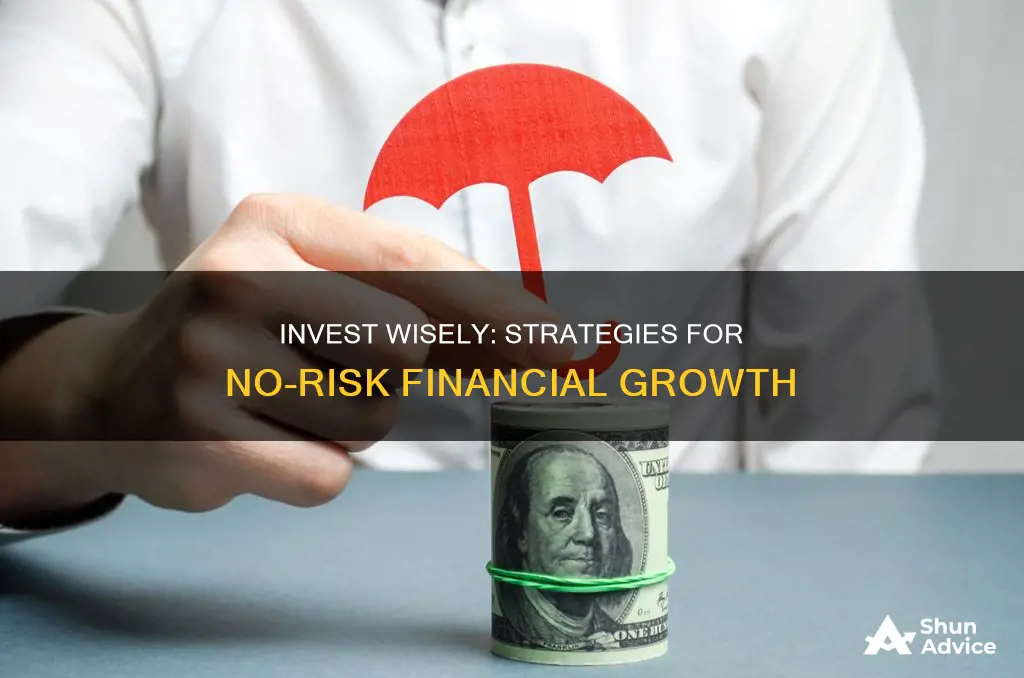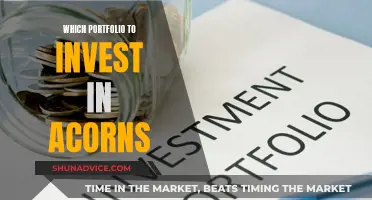
Investing is all about balancing risk and reward. While there is no such thing as a completely risk-free investment, some options are safer than others. These include money market accounts, high-yield savings accounts, cash management accounts, certificates of deposit (CDs), and Treasury notes, bills and bonds. These investments are considered low-risk because they are insured or backed by the government, making it very unlikely that you will lose your principal. However, the trade-off is that they typically offer lower returns compared to riskier investments.
| Characteristics | Values |
|---|---|
| Returns | Low |
| Risk | Low |
| Liquidity | High |
| Safety | High |
| Volatility | Low |
| Accessibility | High |
What You'll Learn

High-yield savings accounts
There are a few things to keep in mind when considering a high-yield savings account. Firstly, interest rates are variable and can change at any time. While your money will likely grow faster than in a traditional savings account, it may not be the best option for long-term wealth generation, as the yield often doesn't keep up with inflation. Additionally, some accounts have monthly fees and minimum balance requirements, and there may be limits on withdrawals. It's important to read the fine print and understand the terms and conditions of the account before opening one.
Overall, high-yield savings accounts are a great option for those looking for a low-risk way to grow their money. They offer a higher APY than traditional savings accounts, and your money is protected by the FDIC or NCUA. However, it's important to remember that interest rates can fluctuate, and there may be some limitations and fees associated with these accounts.
Questions to Ask Your Investment Manager: A Guide
You may want to see also

Money market funds
While money market funds are considered very low-risk, they are not entirely risk-free. There have been rare instances where money market funds have lost investors money. For example, during the 2008 financial crisis, a large money market fund broke the buck, triggering a run on the whole money market industry. Since then, new rules have been introduced to increase the stability of money market funds.
Overall, money market funds are a good option for those seeking a safe, liquid investment with modest returns.
Investing: Ownership, Rights, and Responsibilities Explained
You may want to see also

Short-term certificates of deposit
CDs are ideal for investors who don't need immediate access to their funds and are happy to lock them away for a set period in exchange for a guaranteed, higher rate of interest. This makes them a good option for those saving for short-term financial goals.
When choosing a CD, you'll want to shop around online to compare what banks offer. You can also choose between a short-term CD or a no-penalty CD, which lets you withdraw your money early without incurring a typical early withdrawal penalty.
While CDs are a stable and low-risk investment option, there are a few risks to consider. Firstly, if you remove funds from a CD early, you will usually lose some of the interest you have earned. Some banks may also charge you a penalty fee, so it's important to read the rules and check CD rates before investing. Additionally, if you lock yourself into a longer-term CD and rates rise, you may be earning less than you could be. To access a higher market rate, you'll need to cancel the CD and will likely have to pay a penalty.
Overall, short-term CDs are a great option for those seeking a low-risk investment with higher returns than a savings account. Just be sure to carefully consider the terms and conditions before investing.
Equities: When Should Clients Take the Plunge?
You may want to see also

Cash management accounts
The advantages of a cash management account include:
- Higher FDIC insurance limits (up to $8 million for individual accounts)
- Potentially higher interest rates than traditional savings accounts
- Lower fees than traditional bank accounts
- Fee-free ATMs
- Competitive annual percentage yield (APY)
- No overdraft fees
- No monthly fees
- No minimum balance requirements
However, there are also some disadvantages:
- Some accounts have minimum balance requirements to access all features
- They are often online-only, with no face-to-face customer service
- You may not be able to deposit cash via an ATM
- You may not be able to get a cashier's check
- You may not be able to order physical foreign currency for international travel
When choosing a cash management account, it is important to compare features such as interest rates, fees, ATM networks and reimbursement policies, and access to your money (e.g. through a debit card or checkwriting).
Some of the best cash management accounts include those offered by Wealthfront, Fidelity, Charles Schwab, Betterment, and Interactive Brokers. These accounts offer features such as interest on balances, fee-free ATMs, checking benefits, debit cards, and no monthly fees.
Finding Careers in Investment Management: Strategies for Success
You may want to see also

Dividend-paying stocks
However, it's important to note that dividends are not guaranteed and are subject to macroeconomic and company-specific risks. Additionally, companies that pay dividends are not usually leaders in growth. There may also be some potential extra tax burdens, especially for investors who live off the income.
When considering investing in dividend-paying stocks, it's important to evaluate the dividend yield and payout ratio. A payout ratio that is too high—generally above 80%—means the company is putting a large percentage of its income into paying dividends. In some cases, dividend payout ratios can top 100%, meaning the company may be going into debt to pay out dividends.
Overall, dividend-paying stocks can be a good option for investors seeking a more stable and mature investment with a regular income stream. However, it's important to carefully evaluate the stocks and be aware of the potential risks and drawbacks.
Planning an Investment Portfolio in India: A Beginner's Guide
You may want to see also
Frequently asked questions
No-risk investments include high-yield savings accounts, money market accounts, and certificates of deposit (CDs). These options are considered safe because they are FDIC-insured for up to $250,000 per depositor per bank.
No-risk investments provide stability and liquidity, allowing you to access your money quickly and at a low cost. They are ideal for short-term financial goals, such as building an emergency fund or saving for a large purchase.
The main downside of no-risk investments is that they typically offer lower returns compared to riskier investments. Additionally, there is a chance that your purchasing power may decrease over time due to inflation.







